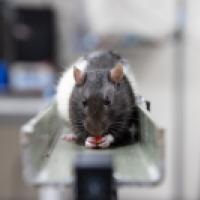After service in the military, Chris Brunkhorst and Caleb Jones sought new outlets to channel their discipline and their commitment to helping others – and they both found it in neuroscience. Now doctoral students in the Cornell’s Meinig School of Biomedical Engineering, Brunkhost and Jones are pursuing different ways to make meaningful impacts on people's lives.
“Our school is very intentional about maintaining an environment that is welcoming for veterans, whether they be members of our staff, faculty, or students,” said Tony Roach, the school’s administrative director and a 28-year veteran of the U.S. Navy. “It makes sense to me that the incredible work being done here to understand and improve human health would be of interest to people, like Chris and Caleb, who were drawn to service.”
 , Click to open gallery view
, Click to open gallery view
Credit: Provided
Caleb Jones outside a hospital in Hrazdan, Armenia, where he was working at during a 2016 humanitarian mission.
A native of Rochester, Minnesota, Brunkhorst joined the U.S. Air Force when he was 18 years old and served his country for eight years – six in the security forces and two as a geospatial analyst. After leaving the military, he wanted to do something in the health care field, but he didn't necessarily want to interface with patients on a daily basis.
“The research I am currently working on is inspired by my belief that we, as a species, must continue exploring our world and beyond it, into our solar system.” Said Brunkhorst, who is currently funded by NASA to investigate how altered gravity impacts protein clearance and accumulation in the brain. “Space flight, especially long duration missions, is extremely dangerous, and there is a lot of work to be done to ensure that it is as safe as possible for those bold enough to explore it.”
The impact of microgravity on the brain could negatively affect an astronaut’s ability to safely complete long duration space missions, said Brunkhorst, who conducts his research under the guidance of Nozomi Nishimura, associate professor in biomedical engineering.
Additionally, by understanding how proteins are normally cleared in the brain and how that differs in diseases, Brunkhorst and other researchers are hoping to determine underlying mechanisms of protein transport which will one day lead to courses of treatment for neurodegenerative diseases.
“I am using a novel genetically encoded secretion tracer to study protein clearance and aggregation in the brain in disease states, such as Alzheimer's disease,” said Brunkhorst. “Our novel tracer allows us to monitor protein transport that closely mimics endogenously secreted proteins, instead of relying on acutely injected dyes and proteins like those used in previous experiments.”
Jones is also originally from the Midwest, hailing from Colwich, Kansas. After five years in the Kansas Air National Guard, including nearly two as a full-time aerospace medical technician, he became interested in how our brains predict and interpret environmental stimuli to modify actions. Having worked extensively in many different research environments, he has a diverse set of skills – ranging from computer programming to surgical procedures – that he can call on in his exploration of this topic.
“My expertise is in systems engineering and medicine, which I have applied during my Ph.D. to set up real-time feedback systems for complex experiments that involve awake-behaving brain recordings,” he said. “Now, my current project involves using novel machine learning methods to analyze complex vocalizations of parrots and correlate them with neural output of the vocal motor cortex.”
 , Click to open gallery view
, Click to open gallery view
Credit: Charissa King-O'Brien
Following his time in the Kansas Air National Guard, Caleb Jones researches neuroscience in the Goldberg Lab at Cornell.
Jones works with Meinig School graduate field member Jesse Goldberg, associate professor of neurobiology and behavior in Cornell’s College of Arts and Sciences, researching the process by which humans learn new things and how it often involves trial and error. They particularly study zebra finches, which learn to sing a song over the course of several weeks. Jones and other researchers leverage brain circuit similarities in songbirds and humans to make discoveries about the underlying neural mechanisms of learning.
“We are particularly interested in a brain circuit involved in learning that is conserved across many species,” Jones said. “This generally involves interconnectivity between the cortex, thalamus and basal ganglia. These circuits are associated with movement disorders such as Parkinson’s, Huntington’s and dystonia, as well as psychiatric disorders including schizophrenia and addiction.”
Many of the questions that Jones currently pursues in his research were inspired, in part, by his military service. “I got to perform a lot of hands-on patient care in military medicine, but quickly realized I was much more interested in the underlying theory that motivates medical interventions,” Jones said. “Neuropsychiatric illnesses were the most interesting to me, so I decided to study neuroscience.”
Brunkhorst expressed a similar sentiment. “I liked the idea of designing, building or creating something that might be beneficial beyond my original scope or purpose for it,” he said. “Biomedical engineering seemed like a good fit for me.
Patrick Gillespie is a communications specialist with Cornell Engineering.






